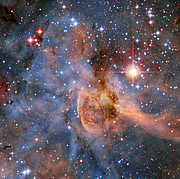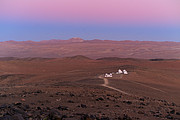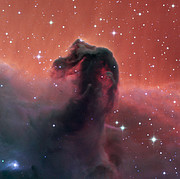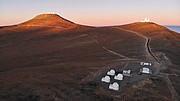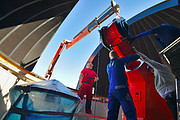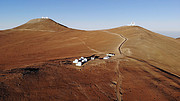Press Release
First Light for SPECULOOS
Four telescopes devoted to the search for habitable planets around nearby ultra-cool stars get off to a successful start at ESO’s Paranal Observatory
5 December 2018
The SPECULOOS project has made its first observations at the European Southern Observatory’s Paranal Observatory in northern Chile. SPECULOOS will focus on detecting Earth-sized planets orbiting nearby ultra-cool stars and brown dwarfs.
The SPECULOOS Southern Observatory (SSO) has been successfully installed at the Paranal Observatory and has obtained its first engineering and calibration images — a process known as first light. After finishing this commissioning phase, this new array of planet-hunting telescopes will begin scientific operations, starting in earnest in January 2019.
SSO is the core facility of a new exoplanet-hunting project called Search for habitable Planets EClipsing ULtra-cOOl Stars (SPECULOOS) [1], and consists of four telescopes equipped with 1-metre primary mirrors. The telescopes — named Io, Europa, Ganymede and Callisto after the four Galilean moons of Jupiter — will enjoy pristine observing conditions at the Paranal site, which is also home to ESO’s flagship Very Large Telescope (VLT). Paranal provides a near-perfect site for astronomy, with dark skies and a stable, arid climate.
These telescopes have a momentous task — SPECULOOS aims to search for potentially habitable Earth-sized planets surrounding ultra-cool stars or brown dwarfs, whose planetary populations are still mostly unexplored. Only a few exoplanets have been found orbiting such stars, and even fewer lie within their parent star’s habitable zone. Even though these dim stars are hard to observe, they are abundant — comprising about 15% of the stars in the nearby universe. SPECULOOS is designed to explore 1000 such stars, including the nearest, brightest, and smallest, in search of Earth-sized habitable planets.
“SPECULOOS gives us an unprecedented ability to detect terrestrial planets eclipsing some of our smallest and coolest neighbouring stars,” elaborated Michaël Gillon of the University of Liège, principal investigator of the SPECULOOS project. “This is a unique opportunity to uncover the details of these nearby worlds.”
SPECULOOS will search for exoplanets using the transit method [2], following the example of its prototype TRAPPIST-South telescope at ESO’s La Silla Observatory. That telescope has been operational since 2011 and detected the famous TRAPPIST-1 planetary system. As a planet passes in front of its star it blocks some of the star’s light — essentially causing a small partial eclipse — resulting in a subtle but detectable dimming of the star. Exoplanets with smaller host stars block more of their star’s light during a transit, making these periodic eclipses much easier to detect than those associated with larger stars.
Thus far, only a small fraction of the exoplanets detected by this method have been Earth-sized or smaller. However, the small size of the SPECULOOS target stars combined with the high sensitivity of its telescopes allows detection of Earth-sized transiting planets located in the habitable zone. These planets will be ideally suited for follow-up observations with large ground- or space-based facilities.
“The telescopes are kitted out with cameras that are highly sensitive in the near-infrared,” explained Laetitia Delrez of the Cavendish Laboratory, Cambridge, a co-investigator in the SPECULOOS team. “This radiation is a little beyond what human eyes can detect, and is the primary emission from the dim stars SPECULOOS will be targeting.”
The telescopes and their brightly coloured mounts were built by the German company ASTELCO and are protected by domes made by the Italian manufacturer Gambato. The project will receive support from the two TRAPPIST 60-cm telescopes, one at ESO’s La Silla Observatory and the other in Morocco [3]. The project will in due course also include the SPECULOOS Northern Observatory and SAINT-Ex, which are currently under construction in Tenerife, Spain, and at San Pedro Mártir, Mexico, respectively.
There is also potential for an exciting future collaboration with the Extremely Large Telescope (ELT), ESO’s future flagship telescope, currently under construction on Cerro Armazones. The ELT will be able to observe planets detected by SPECULOOS in unprecedented detail — perhaps even analysing their atmospheres.
“These new telescopes will allow us to investigate nearby Earth-like worlds in the Universe in greater detail than we could have imagined only ten years ago,” concluded Gillon. “These are tremendously exciting times for exoplanet science.”
Notes
[1] Speculoos, or speculaas, is a delicious type of spiced biscuit traditionally baked in Belgium and other countries for Saint Nicholas's day on December 6. The name, with its sweet connotations, reflects the Belgian origins of the SPECULOOS project. The TRAPPIST project also has a similar Belgian namesake — it was named after Trappist beers, most of which are brewed in Belgium.
[2] The transit method is one of several ways exoplanets are discovered. A variety of instruments, including ESO’s planet-hunting HARPS spectrograph at the La Silla Observatory, use the radial velocity method to detect exoplanets, measuring changes in a star’s velocity due to an orbiting exoplanet.
[3] SSO also received funding from the European Research Council under the European Union's Seventh Framework Programme (FP7/2007-2013)/ ERC grant agreement number 336480, from the Simons and MERAC Foundations, and from private sponsors.
More information
ESO is the foremost intergovernmental astronomy organisation in Europe and the world’s most productive ground-based astronomical observatory by far. It has 16 Member States: Austria, Belgium, Czechia, Denmark, France, Finland, Germany, Ireland, Italy, the Netherlands, Poland, Portugal, Spain, Sweden, Switzerland and the United Kingdom, along with the host state of Chile and with Australia as a Strategic Partner. ESO carries out an ambitious programme focused on the design, construction and operation of powerful ground-based observing facilities enabling astronomers to make important scientific discoveries. ESO also plays a leading role in promoting and organising cooperation in astronomical research. ESO operates three unique world-class observing sites in Chile: La Silla, Paranal and Chajnantor. At Paranal, ESO operates the Very Large Telescope and its world-leading Very Large Telescope Interferometer as well as two survey telescopes, VISTA working in the infrared and the visible-light VLT Survey Telescope. ESO is also a major partner in two facilities on Chajnantor, APEX and ALMA, the largest astronomical project in existence. And on Cerro Armazones, close to Paranal, ESO is building the 39-metre Extremely Large Telescope, the ELT, which will become “the world’s biggest eye on the sky”.
The SPECULOOS Southern Observatory (SSO) is a project conducted by the University of Liège (Belgium), the Cavendish Laboratory, Cambridge (UK) and the King Abdulaziz University (Saudi Arabia), under the leadership of Michaël Gillon, research scientist and head of the group EXOplanets in Transit: Identification and Characterization (EXOTIC) at the Department of Astrophysics, Geophysics and Oceanography (AGO) of the University of Liège. SSO also involves scientists from the Universities of Bern, Birmingham, and Warwick. ESO supports SSO and hosts it at the Paranal Observatory in the Chilean Atacama Desert.
Links
Contacts
Michaël Gillon
SPECULOOS Principal Investigator
University of Liège, Belgium
Tel: +32 4366 9743
Cell: +32 473 346 402
Email: michael.gillon@uliege.be
Didier Queloz
SPECULOOS co-Principal Investigator, University of Cambridge
UK
Tel: +44 7746 010890
Email: dq212@cam.ac.uk
Calum Turner
ESO Public Information Officer
Garching bei München, Germany
Tel: +49 89 3200 6670
Cell: +49 151 1537 3591
Email: pio@eso.org
Our use of Cookies
We use cookies that are essential for accessing our websites and using our services. We also use cookies to analyse, measure and improve our websites’ performance, to enable content sharing via social media and to display media content hosted on third-party platforms.
ESO Cookies Policy
The European Organisation for Astronomical Research in the Southern Hemisphere (ESO) is the pre-eminent intergovernmental science and technology organisation in astronomy. It carries out an ambitious programme focused on the design, construction and operation of powerful ground-based observing facilities for astronomy.
This Cookies Policy is intended to provide clarity by outlining the cookies used on the ESO public websites, their functions, the options you have for controlling them, and the ways you can contact us for additional details.
What are cookies?
Cookies are small pieces of data stored on your device by websites you visit. They serve various purposes, such as remembering login credentials and preferences and enhance your browsing experience.
Categories of cookies we use
Essential cookies (always active): These cookies are strictly necessary for the proper functioning of our website. Without these cookies, the website cannot operate correctly, and certain services, such as logging in or accessing secure areas, may not be available; because they are essential for the website’s operation, they cannot be disabled.
Functional Cookies: These cookies enhance your browsing experience by enabling additional features and personalization, such as remembering your preferences and settings. While not strictly necessary for the website to function, they improve usability and convenience; these cookies are only placed if you provide your consent.
Analytics cookies: These cookies collect information about how visitors interact with our website, such as which pages are visited most often and how users navigate the site. This data helps us improve website performance, optimize content, and enhance the user experience; these cookies are only placed if you provide your consent. We use the following analytics cookies.
Matomo Cookies:
This website uses Matomo (formerly Piwik), an open source software which enables the statistical analysis of website visits. Matomo uses cookies (text files) which are saved on your computer and which allow us to analyze how you use our website. The website user information generated by the cookies will only be saved on the servers of our IT Department. We use this information to analyze www.eso.org visits and to prepare reports on website activities. These data will not be disclosed to third parties.
On behalf of ESO, Matomo will use this information for the purpose of evaluating your use of the website, compiling reports on website activity and providing other services relating to website activity and internet usage.
Matomo cookies settings:
Additional Third-party cookies on ESO websites: some of our pages display content from external providers, e.g. YouTube.
Such third-party services are outside of ESO control and may, at any time, change their terms of service, use of cookies, etc.
YouTube: Some videos on the ESO website are embedded from ESO’s official YouTube channel. We have enabled YouTube’s privacy-enhanced mode, meaning that no cookies are set unless the user actively clicks on the video to play it. Additionally, in this mode, YouTube does not store any personally identifiable cookie data for embedded video playbacks. For more details, please refer to YouTube’s embedding videos information page.
Cookies can also be classified based on the following elements.
Regarding the domain, there are:
- First-party cookies, set by the website you are currently visiting. They are stored by the same domain that you are browsing and are used to enhance your experience on that site;
- Third-party cookies, set by a domain other than the one you are currently visiting.
As for their duration, cookies can be:
- Browser-session cookies, which are deleted when the user closes the browser;
- Stored cookies, which stay on the user's device for a predetermined period of time.
How to manage cookies
Cookie settings: You can modify your cookie choices for the ESO webpages at any time by clicking on the link Cookie settings at the bottom of any page.
In your browser: If you wish to delete cookies or instruct your browser to delete or block cookies by default, please visit the help pages of your browser:
Please be aware that if you delete or decline cookies, certain functionalities of our website may be not be available and your browsing experience may be affected.
You can set most browsers to prevent any cookies being placed on your device, but you may then have to manually adjust some preferences every time you visit a site/page. And some services and functionalities may not work properly at all (e.g. profile logging-in, shop check out).
Updates to the ESO Cookies Policy
The ESO Cookies Policy may be subject to future updates, which will be made available on this page.
Additional information
For any queries related to cookies, please contact: pdprATesoDOTorg.
As ESO public webpages are managed by our Department of Communication, your questions will be dealt with the support of the said Department.


